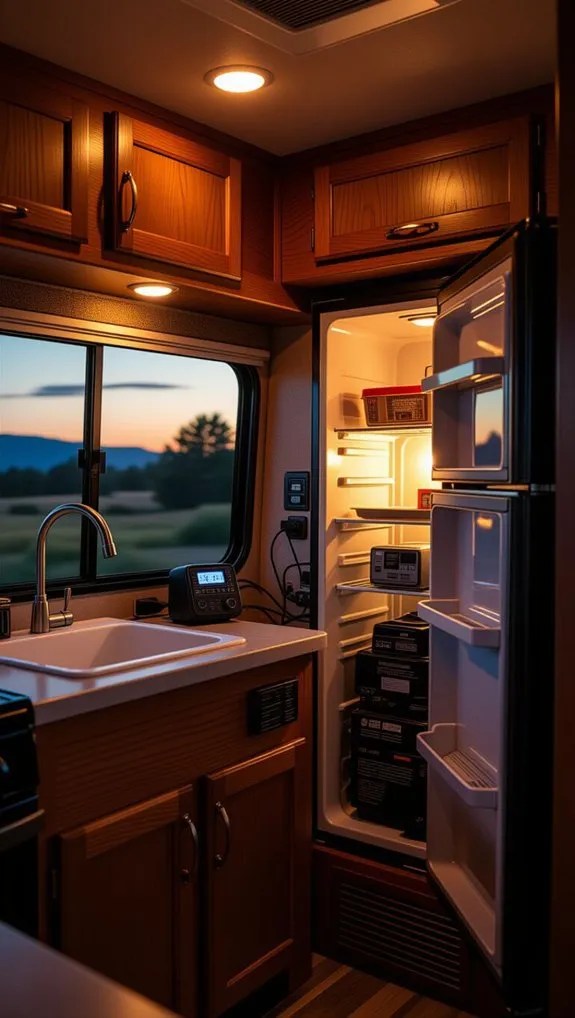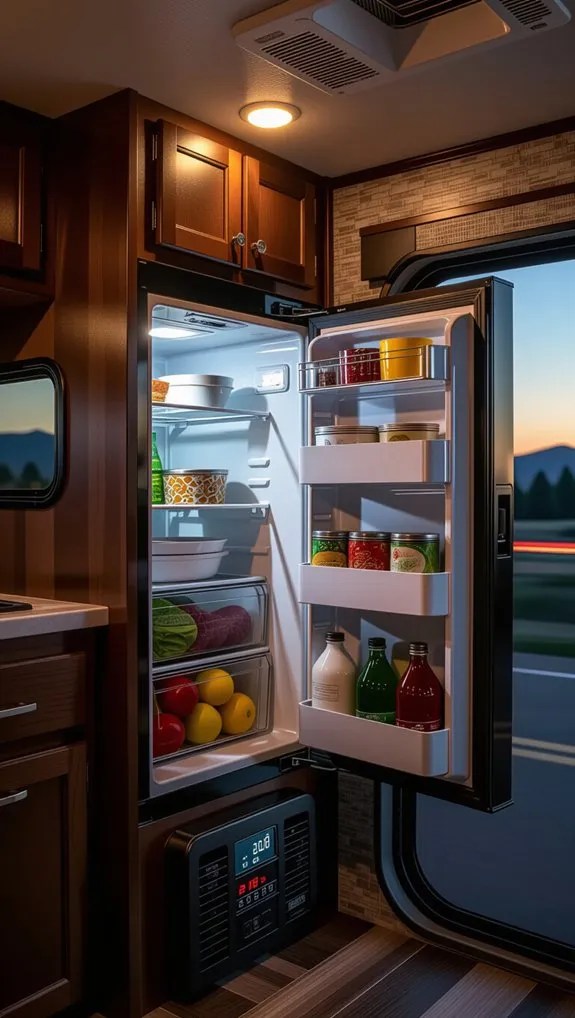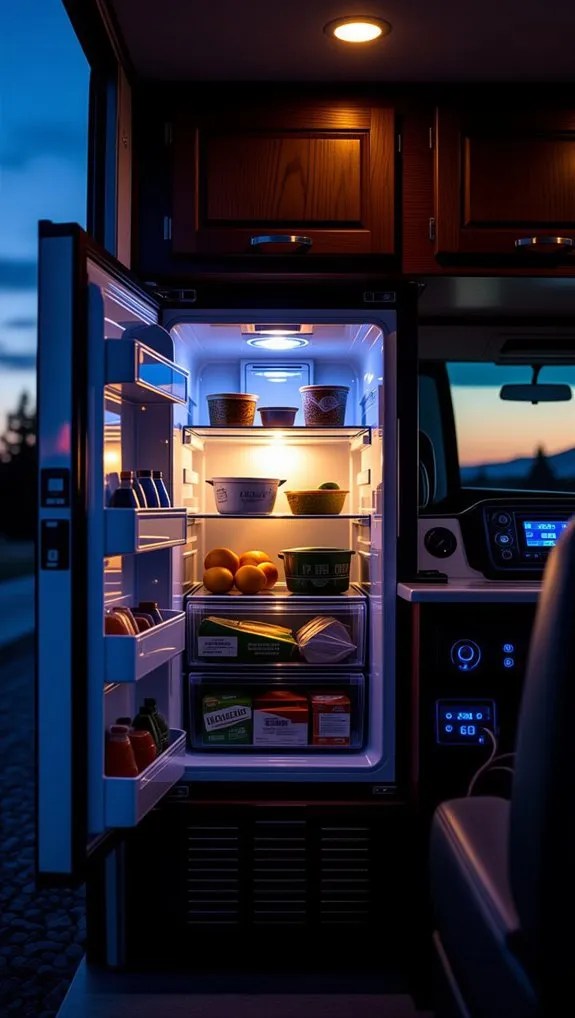Ever wondered “can the RV generator run the refrigerator while driving?” You’re definitely not alone in asking this question. Many RV enthusiasts find themselves puzzling over whether it’s safe and practical to fire up their generator while rolling down the interstate, especially during those long summer road trips when keeping food fresh becomes a real concern.
The short answer is yes, your RV generator can typically run your refrigerator while driving, but there’s much more to consider than simply hitting the power button. From understanding your specific power needs and safety requirements to navigating state regulations and potential mechanical challenges, running a generator on the road involves several important factors.
In this post, we’ll walk you through everything you need to know about operating your RV generator while driving, including when it makes sense, potential risks to watch out for, and practical alternatives that might work better for your travel style. By the end, you’ll have the confidence to make the right choice for your next adventure.
Can the RV generator run fridge driving?

While many RV owners wonder about powering their refrigerator during travel, the good news is that most RV generators can indeed run your fridge while you’re on the road.
Your RV generator can keep your refrigerator cool by powering the 120 VAC electric mode during driving. This means no more warm drinks or spoiled food mid-journey!
Just remember that running the generator consumes fuel, typically 0.3–0.7 gallons per hour, so plan accordingly.
If your propane refrigerator is an option and local regulations permit, that’s another great alternative for maintaining cool temperatures while cruising down the highway.
Is it safe to run generator?
Given the potential risks involved with running an RV generator while driving, safety becomes a paramount concern for most travelers.
Ensuring your generator is in top condition is crucial before attempting to power your refrigerator on the road. Check exhaust systems, mounting points, and electrical connections to minimize fire and carbon monoxide risks.
Local laws and campground regulations may restrict generator use while driving, so always verify compliance.
If you’re unsure about running the generator, consider alternative cooling methods like inverter systems or propane settings. Prioritize safety to keep your food cold and your journey worry-free.
How much power does RV fridge need?

Power up your RV refrigerator knowledge with a clear breakdown of electrical needs that’ll keep your cool treats frosty mile after mile.
Most RV fridges draw 100-200 watts when running, whether connected to shore power, batteries, or running through an inverter.
Your engine’s electrical system and generator can typically handle this load, with small 1,500-2,000 watt generators perfectly suited for continuous refrigerator operation.
When driving, remember that an inverter adds about 10-15% power draw, so a 200-watt fridge might actually consume around 250 watts from your battery system.
Smart power management keeps your food cool and your journey smooth.
Ways to power fridge while driving
RV owners can kick back and cool down knowing they’ve got multiple reliable ways to power their refrigerator while cruising down the highway. The RV generator, house batteries, and engine alternator offer flexible cooling solutions for life on the road.
| Power Source | Pros | Cons |
|---|---|---|
| RV Generator | Consistent Power | Fuel Consumption |
| House Batteries + Inverter | Silent Operation | Limited Battery Capacity |
| Engine Alternator | Free Power | Requires Proper Wiring |
| Solar Panels | Eco-Friendly | Weather Dependent |
| Shore Power | Unlimited | Stationary Only |
Smart RV owners choose the right combination to keep their refrigerator running smoothly during travel.
How to run fridge on generator safely

When running your RV generator to power the fridge while driving, you’ll want to nail down a safe setup that protects both your appliance and your passengers.
Proper ventilation is critical, so I always recommend mounting the generator in a well-ventilated bay or external mount and ensuring exhaust doesn’t leak into living spaces.
Carbon monoxide alarms are your best defense, so install and check them regularly to give you peace of mind that you’re keeping your cooling system running without risking your family’s safety.
Safe setup
While running your RV refrigerator during transit might seem complicated, I’ll walk you through creating a safe generator setup that keeps your food cold and your journey worry-free.
Your generator needs a proper transfer switch to prevent electrical backfeeding and manage surge power requirements. Route the exhaust carefully away from your coach’s intake areas to avoid dangerous carbon monoxide buildup.
I recommend installing an automatic transfer switch that provides stable 120 VAC power directly to your refrigerator. Double-check your generator’s wattage capacity matches your fridge’s startup and running electrical demands for seamless, safe cooling during travel.
Ventilation check
Because proper ventilation can make or break your generator and refrigerator’s performance during travel, grasping critical airflow requirements isn’t just smart—it’s essential for safe, reliable cooling.
When running your generator, monitor generator exhaust routes carefully, ensuring they’re directed away from coach windows and vents.
Always use a carbon monoxide detector and verify clearance distances per manufacturer recommendations.
Check exterior vents for blockages, and confirm combustion air intakes remain unobstructed.
Proper ventilation prevents dangerous CO buildup and maintains optimal cooling performance, keeping your food fresh and your journey worry-free.
CO alarms
Carbon monoxide (CO) alarms are critically important when running an RV refrigerator on a generator while driving, as they serve as your first line of defense against potentially fatal gas buildup.
I always recommend installing battery-backed CO detectors near generator exhaust areas, testing them monthly, and replacing sensors every 5-7 years.
These lifesaving devices alert you to dangerous CO levels from generator emissions before they become deadly.
Additionally, I suggest installing redundant propane and CO alarms for maximum safety.
If any alarm sounds, immediately turn off the generator, evacuate the RV, and ventilate thoroughly to protect yourself and your passengers.
How to keep fridge cold while driving

When you’re cruising down the highway, keeping your RV fridge cold isn’t just about running a generator—it’s about smart preparation and strategic cooling tactics.
I’ve learned that pre-cooling your refrigerator before departure, minimizing door openings, and strategically monitoring internal temperatures can make a massive difference in maintaining food safety and quality during long drives.
Pre-cool tips
Let’s lock down the best strategies to keep your RV refrigerator perfectly chilled during travel.
Set the fridge to its coldest setting at least 1-2 hours before departure to maximize thermal mass.
Run the generator on a fully charged battery bank to ensure consistent cooling.
Pack frequently accessed items in an external cooler to minimize door openings.
Use large frozen gel packs or ice blocks as thermal ballast in the freezer.
Always load pre-chilled items and avoid adding warm food, which can dramatically increase internal temperature recovery time.
Door discipline
Since managing your RV refrigerator’s internal temperature during travel requires strategic planning, door discipline becomes a critical factor in maintaining food safety and cooling efficiency.
Keep the fridge door closed as much as possible, minimizing temperature fluctuations.
Group items by frequency of use, placing commonly accessed foods in an easily reachable spot.
Pre-chill the refrigerator before departure to create a thermal buffer.
When you must open the door, do it quickly and purposefully, then allow 15–30 minutes for temperature recovery.
This approach ensures your food stays cold and fresh throughout your journey.
Temperature monitoring
Monitoring your RV refrigerator’s temperature during travel isn’t just a good practice—it’s essential for food safety and preservation.
To keep your food cold, I recommend using a compact digital probe or Bluetooth datalogger placed in the coldest compartment. Pre-cool the refrigerator before your trip and aim to maintain temperatures below 40°F for the fridge and 0°F for the freezer.
Verify your inverter charges the batteries consistently, ensuring stable cooling.
What loads to avoid with generator

Navigating generator loads can make or break your RV refrigerator‘s performance while on the road. Your RV generator must carefully balance electrical demands to run the refrigerator successfully.
High-draw appliances like air conditioners, electric cooking tools, and motor-driven equipment can quickly overwhelm your generator’s capacity. An inverter/charger helps manage these challenges, but you’ll want to strategically manage your electrical loads.
Avoid simultaneously running multiple high-wattage devices that could trip breakers or reduce generator efficiency. By grasping and planning your power consumption, you’ll ensure your refrigerator stays cool and your generator operates smoothly during travel.
Propane versus generator for road cooling
After carefully managing electrical loads, RV owners face another critical decision: whether to run their refrigerator on propane or generator power while driving.
Running the RV generator provides a safer, more reliable cooling option compared to propane operation. While a propane refrigerator might work, many manufacturers advise against it due to potential safety risks.
The generator eliminates concerns about flame or vapor movement, and can handle the inverter’s startup surge without draining your battery. Plus, you’ll avoid potential insurance complications and ensure consistent, cool temperatures for your food throughout the journey.
Troubleshooting fridge not cooling on road

When your RV refrigerator decides to play dead on the road, you’ll want to zero in on the root cause fast.
Start by checking your inverter’s status and ensuring it’s properly connected to the battery bank.
Verify the shore power or alternator is charging your house batteries, maintaining voltage between 13.2–14.4 V.
Inspect power transfer switches, breakers, and fuses for any tripped components blocking 120V operation.
If you’ve got a propane-capable fridge, test its LP cooling performance to isolate whether the issue stems from electrical power loss or fuel ignition problems while driving.
Best practices and quick safety checklist
Because safe generator operation can make or break your RV refrigeration strategy, I’ll walk you through a comprehensive safety checklist that ensures your food stays cold without compromising your journey.
3 Critical Safety Practices for Running Your RV Generator:
- Verify generator watts match refrigerator startup surge requirements
- Secure generator to prevent vibration during road travel
- Monitor inverter/generator load to avoid battery drainage
Running the refrigerator while driving demands careful attention. Always check manufacturer guidelines, maintain proper ventilation, and ensure exhaust clearance.
With the right precautions, you’ll keep your food cold and enjoy a worry-free road trip.
Frequently Asked Questions
How Do I Keep My RV Refrigerator Running While Driving?
I run my RV fridge while driving by using my built-in generator or connecting an inverter to my house battery bank, ensuring I’ve got adequate power and charging to keep it cool during travel.
Can I Run My Generator in My RV While Driving?
Yes, I can run my RV generator while driving, but I’ll check my manufacturer’s manual first. I’ll ensure proper mounting, cooling, and follow local regulations to safely power my refrigerator and charge batteries during transit.
How Does a Residential Refrigerator Work in an RV When Driving?
I power my RV’s residential fridge while driving using my onboard generator or an inverter connected to my house batteries. The alternator charges the batteries, ensuring my fridge runs smoothly without interruption during travel.
Can RV Fridge Run on Battery While Driving?
Yes, I can run my RV’s residential fridge on batteries while driving. With a robust inverter and healthy house batteries, my refrigerator operates smoothly, powered by converting DC to AC during travel.
In Conclusion
Running your RV generator while driving is not only possible but often the best solution for keeping your refrigerator operational during long journeys. With proper planning and the right equipment, you can maintain consistent cooling power without draining your house batteries or risking spoiled food. The key lies in understanding your power requirements, ensuring adequate ventilation, and following manufacturer safety guidelines.
Whether you’re embarking on a cross-country adventure or simply heading to your favorite camping spot, having a reliable cooling system transforms your travel experience from stressful to seamless. To find the perfect refrigerator that works efficiently with your generator setup, check out our comprehensive RV refrigerator reviews where we’ve tested and evaluated the most reliable, energy-efficient models designed specifically for life on the road.

